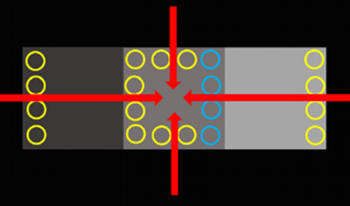References
1BarlowH. B.
2BillockV. A.2018Hue opponency: chromatic valence functions, individual differences, cortical winner-take-all opponent modeling, and the relationship between spikes and sensitivityJ. Opt. Soc. Am. A35B267B277B267–7710.1364/JOSAA.35.00B267
3BlakesleeB.McCourtM. E.1999A multiscale spatial filtering account of the White effect, simultaneous brightness contrast and grating inductionVision Res.39436143774361–7710.1167/9.3.22
4BlakesleeB.ReetzD.McCourtM. E.2009Spatial filtering versus anchoring accounts of brightness/lightness perception in staircase and simultaneous brightness/lightness contrast stimuliJ. Vision910.1068/p3103
5BressanP.Actis-GrossoR.2001Simultaneous lightness contrast with double incrementsPerception30889897889–9710.3758/BF03206499
6CataliottiJ.GilchristA. L.1995Local and global processes in lightness perceptionPercept. Psychophys.57125135125–3510.3758/BF03207497
7CohenM. A.GrossbergS.1984Neural dynamics of brightness perception: features, boundaries, diffusion, and resonancePercept. Psychophys.36428456428–5610.3758/BF03213045
8ColeR. E.DiamondA. L.1971Amount of surround and test inducing separation in simultaneous lightness contrastPercept. Psychophys.9125128125–810.1364/JOSA.56.000966
9De ValoisR. L.AbramovI.JacobsG. H.1966Analysis of response patterns of LGN cellsJ. Opt. Soc. Am.56966977966–7710.1163/156856809786618484
10FangL.GrossbergS.2009From stereogram to surface: how the brain sees the world in depthSpatial Vis.22458245–8210.1016/j.visres.2015.10.007
11GalmonteA.SoranzoA.RuddM. E.AgostiniT.2015The phantom illusionVision Res.117495849–58
12GelbA.von BetheW. A.1929Die ‘Farbenkonstanz’ der SehdingeHandbuch der Normal und Pathologische PsychologieVol. 12594678594–678SpringerBerlin
13GilchristA.Seeing Black and White2006Oxford University PressNew York
14GilchristA.CataliottiJ.1994Anchoring of surface lightness with multiple illumination levelsInvestigative Ophthalmology and Visual Science35S216510.1167/9.9.13
15GilchristA. L.RadonjićA.2009Anchoring of lightness values by relative luminance and relative areaJ. Vision913, 11013, 1–1010.1167/10.5.6
16GilchristA. L.RadonjićA.2010Functional frameworks of illumination revealed by probe disk techniqueJ. Vision1010.1037/0033-295X.106.4.795
17GilchristA.KossyfidisC.BonatoF.AgostiniT.CataliottiJ.LiX.SpeharB.AnnanV.EconomouE.1999An anchoring theory of lightness perceptionPsychol. Rev.106795834795–834
18GrossbergS.PessoaL.DeWeerdP.2003Filling-in the forms: Surface and boundary interactions in visual cortexFilling-in: From Perceptual Completion to Skill Learning133713–37Oxford University PressNew York
19GrossbergS.MingollaE.1985Neural dynamics of form perception: boundary completion, illusory figures, and neon color spreadingPsychol. Rev.92173211173–21110.3758/BF03207869
20GrossbergS.TodorovićD.1988Neural dynamics of 1-D and 2-D brightness perception: a unified model of classical and recent phenomenaPercept. Psychophys.43241277241–7710.1037/h0040919
21HeinemannE. G.1955Simultaneous brightness induction as a function of inducing- and test-field luminancesJ. Exp. Psychol.50899689–96
22HeinemannE. G.JamesonD.HurvichL.1972Simultaneous brightness inductionHandbook of Sensory PhysiologyVol. VII/4146169146–69SpringerBerlin
23HubelD. H.Eye, Brain, and Vision1988W. H. FreemanNew York
24D.JamesonL. M.Hurvich1961Complexities of perceived brightnessScience133174179174–910.1167/18.13.1
25KardosL.1934Ding und Schatten [Thing and shadow]Zeitschrift für Psychologie, Erg bd.2310.1152/jn.1953.16.1.37
26KimM.GoldJ. M.MurrayR. F.2018What image features guide lightness perception?J. Vis.181201–2010.1073/pnas.83.10.3078
27KufflerS. W.1953Discharge patterns and functional organization of mammalian retinaJ. Neurophysiol.16376837–6810.1364/JOSA.61.000001
28LandE. H.1986An alternative technique for the computation of the designator in the retinex theory of color visionProc. Natl. Acad. Sci. USA83307830803078–8010.1037/h0062595
29LandE. H.McCannJ. J.1971Lightness and retinex theoryJ. Opt. Soc. Am.611111–11
30LeibowitzH.MoteF. A.ThurlowW. R.1953Simultaneous contrast as a function of separation between test and inducing fieldsJ. Exp. Psychol.46453456453–610.1113/jphysiol.1966.sp008001
31LiX.GilchristA.1999Relative area and relative luminance combine to anchor surface lightness valuesPercept. Psychophys.61771785771–8510.1016/0042-6989(88)90013-2
32McCourtM. E.BlakesleeB.CopeD.2016The oriented difference-of-Gaussians model of brightness perceptionJ. Electron. Imaging6191–910.1073/pnas.0503887102
33MunsellA. H.Munsell Book of Color: Defining, Explaining and Illustrating the Fundamental Characteristics of Color1929Munsell Color Company
34NakaK. I.RushtonW. A.1966S-potentials from colour units in the retina of fish (Cyprinidae)J. Physiol. (London)185536555536–5510.1167/13.14.18
35ReidR. C.ShapleyR.1988Brightness induction by local contrast and the spatial dependence of assimilationVision Res.28115132115–3210.3389/fnhum.2014.00640
36RomneyA. K.D’AndradeR. G.IndowT.2005The distribution of response spectra in the lateral geniculate nucleus compared with reflectance spectra of Munsell color chipsProc. Natl. Acad. Sci. USA102972097259720–5
37RuddM. E.2010How attention and contrast gain control interact to regulate lightness contrast and assimilationJ. Vision104010.1117/1.JEI.26.3.031209
38RuddM. E.2013Edge integration in achromatic color perception and the lightness-darkness asymmetryJ. Vision131810.1364/JOSAA.24.002766
39RuddM. E.2014A cortical edge-integration model of object-based lightness computation that explains effects of spatial context and individual differencesFront. Hum. Neurosci.81141–1410.1167/5.11.5
40RuddM. E.Retinex-like computations in human lightness perception and their possible realization in visual cortexProc. Imag. Sci. Tech. Intl. Symp. Electr. Imag. IS&T Electronic Imaging: Retinex at 50 20162016IS&TSpringfield, VA
41RuddM. E.2017Lightness computation by the human visual systemJ. Electron. Imaging2603120910.1364/JOSAA.24.002134
42RuddM. E.PopaD.2007Stevens’ brightness law, contrast gain control, and edge integration in achromatic color perception: A unified modelJ. Opt. Soc. Am. A24276627822766–8210.1073/pnas.82.17.5983
43RuddM. E.ZemachI. K.2005The highest luminance rule in achromatic color perception: Some counterexamples and an alternative theoryJ. Vision59831003983–100310.3758/BF03213048
44RuddM. E.ZemachI. K.2004Quantitative studies of achromatic color induction: An edge integration analysisVision Res.44971981971–8110.1126/science.6539501
45RuddM. E.ZemachI. K.2007Contrast polarity and edge integration in achromatic color perceptionJ. Opt. Soc. Am. A24213421562134–5610.1037/h0053804
46ShapleyR.ReidR. C.1985Contrast and assimilation in the perception of brightnessProc. Natl. Acad. Sci. USA82598359865983–610.1038/scientificamerican0163-107
47StevensJ. C.1967Brightness inhibition re size of surroundPercept. Psychophys.2189192189–92
48StiehlW. A.McCannJ. J.SavoyR. L.1983Influence of intraocular scattered light on lightness-scaling experimentsJ. Opt. Soc. Am.73114311481143–810.1177/2041669518787212
49von der HeydtR.PeterhansE.BaumgartnerG.1984Illusory contours and cortical neuronsScience224126012621260–210.1364/JOSAA.24.001830
50WallachH.1948Brightness constancy and the nature of achromatic colorsJ. Exp. Psychol.38310324310–2410.1523/JNEUROSCI.20-17-06594.2000
51WallachH.1963The perception of neutral colorsScientific American208107116107–16
52ZavagnoD.AnnanV.CaputoG.2004The problem of being white: Testing the highest luminance ruleVision16149159149–59
53ZavagnoD.DaneykoO.LiuZ.2018The influence of physical illumination on lightness perception in simultaneous contrast displaysi-Percept.91221–22
54ZemachI. K.RuddM. E.2007Effects of surround articulation on lightness depend on the spatial arrangement of the articulated regionJ. Opt. Soc. Am. A24183018411830–41
55ZhouH.FriedmanH. S.von der HeydtR.2000Coding of border ownership in monkey visual cortexJ. Neurosci.20659466116594–611

 Find this author on Google Scholar
Find this author on Google Scholar Find this author on PubMed
Find this author on PubMed